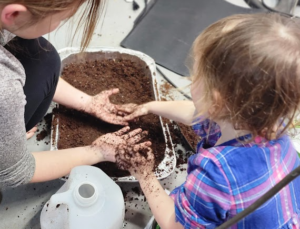Growing pepper seedlings is an exciting and fulfilling endeavor, especially for beginning gardeners. At Ohio Peppers, we’re here to guide you through every step, from selecting the right soil mix to nurturing your seedlings to robust plants. Let’s embark on this gardening adventure together!
Choosing the Right Soil Mix for Starting Pepper Seeds
Quality brands of potting soil commonly found in stores are suitable for starting pepper seedlings. Potting soil is heavier than seed starting mixes. Lighter mixes specially designed as seed starting mixes, like Jiffy and Burpee, are often best for seedlings, retaining moisture without becoming soggy. Seed starting mixes are preferred for their fine texture, making it easier for young roots to grow. I have to remember that peppers will grow in regular clay soil behind my house if the seeds are accidently dropped. Seed starting mixes may be best but peppers are resilient. Do not stress about the finer nuances of growing peppers!

Planting Depth and Techniques
Planting your seeds correctly sets them up for success. Plant seeds 1/4 inch deep, a depth that provides stability without hindering growth. Pre-moisten the soil mix, so it’s damp but not soggy. Give each seed enough space to grow without competition. Ohio Peppers grows multiple seeds in a single cell and “prick” the seedlings apart during transplanting. If just starting off – keep it simple and put one seed per cell. We use bottom watering, but gentle misting is also fine if it is the only way you have to keep the seeds damp. We recommend domed starting trays to maintain humidity, creating a mini-greenhouse effect.
Video: Depth of seeds and lightly covering with seed starting mix

Pepper Seedling Indoor Moisture Management
Managing moisture is crucial, especially indoors. If you’re not using a domed tray, I have seen others have successes with plastic cling wrap. Remove the wrap when seedlings emerge. Garners with a greenhouse may do not have to be as concerned about maintaining perfect humidity for seedlings. Dry winter homes in the Midwest benefit from a covering. Humidity trays can help maintain the right moisture level, according to popular lore. I have my doubts when facing the dry artic blasts.
A gentle fan helps strengthen seedlings. If using a domed tray, remove it occasionally to expose seedlings to moving air. Remove the dome when seedlings risk touching the top, and periodically when smaller to build strength.
The key focus is avoiding waterlogging which can cause root rot (and other pathogens that thrive in warm damp areas) or provide fungus gnats prime breeding grounds. Bottom watering is our preferred method, ensuring even moisture without disturbing the seeds.
Dealing with Soil Gnats: Soil gnats, also known as fungus gnats, are tiny flying insects that often appear around indoor plants. They lay their eggs in the soil, where the larvae feed on organic matter, sometimes damaging young roots. Prevention is key, and it starts with not overwatering, as soggy soil attracts these pests. Using a well-draining soil mix and allowing the soil surface to dry slightly between waterings can deter them. If you notice soil gnats, yellow sticky traps can capture the adults, while allowing the soil to dry out a bit more than usual can eliminate the larvae. At Ohio Peppers, we also recommend using a domed tray for starting seedlings, as it can create a barrier that helps keep these pests at bay. With careful observation and these simple strategies, you can keep soil gnats from becoming a problem in your pepper seedling journey.

Fertilization of Pepper Seedlings
As your pepper seedlings begin to grow, they require essential nutrients to thrive. The primary nutrients are Nitrogen (N), Phosphorus (P), and Potassium (K), often referred to as the N-P-K ratio on fertilizer labels. Seedlings can experience “failure to launch”. Fertilizer will not help when these issues are the result of genetic defects or pathogenic interaction. A nutrient deficient growing medium can also cause failure in young plants. Most mixes used will include some nutrients. For seedlings, if you feel the need to fertilize, wait until the pepper seedling has emerged. At Ohio Peppers, we recommend starting with a highly watered down solution of a balanced fertilizer, gradually increasing as the seedlings grow. Always follow the instructions on the fertilizer packaging, and consider the nutrients already present in your soil mix. By providing the right nutrients at the right time, you’ll nurture strong, productive pepper plants ready for transplanting into the garden.
Common Mistakes when Caring For Your Pepper Seedling and How to Avoid Them
Avoiding common mistakes ensures healthy growth:
Overwatering: Leads to root rot, a condition where roots become mushy and die. Keep the soil damp but not waterlogged.
Incorrect Temperature: Pepper seeds prefer warmth, around 70–80°F. A plant growing heat mat can help maintain this temperature, promoting faster germination.
Germination Time: Different pepper species may take anywhere from 7 to 21 days to germinate. Patience and careful monitoring are key. C. annuum typically germinate quicker than the superhots of the C. chinense species. Ohio Peppers experiments determined that by 14 days over 90% of viable seeds germinated. The delta between annuum and chinense plants averaged two days quicker for the former. The median germination time was near statistically insignificant. The peppers requiring longer than 14 days, sometimes much longer, were chinense.
Light Conditions: Bright, indirect light for 14-16 hours daily is ideal. Grow lights can provide consistent illumination if natural light is insufficient.
Air Flow: A lack of airflow results in weak plants. This movement triggers the plant to produce growth hormones, leading to thicker and stronger stems. Essentially, the plant senses the movement as a form of stress and responds by reinforcing its structure. This helps the seedlings become more resilient and better able to support the weight of future fruits. Proper airflow also helps with gas exchange, helps prevent diseases – notably those common with overly damp environments, and finally moving air simulates outdoors, preparing a plant for its eventual home.